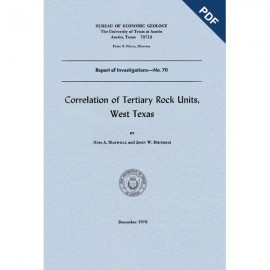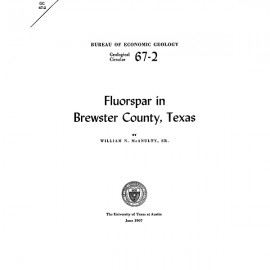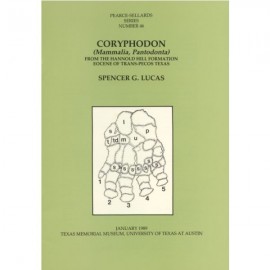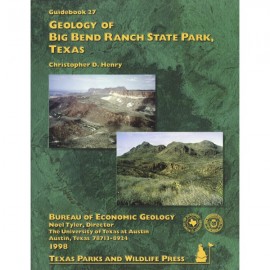Reports of Investigations
-
Books & Reports
- Reports of Investigations
- Guidebooks
- Udden Series
- Geological Circulars
- Down To Earth
- Atlases of Major Oil and Gas Reservoirs
- Texas Memorial Museum Publications
- Environmental Geologic Atlas of the Texas Coastal Zone
- Mineral Resource Circulars
- Other Reports
- Seminars and Workshops
- Handbooks
- Submerged Lands of Texas
- Symposia
- Annual Reports
- Open File Reports
-
Maps & Cross Sections
- Thematic Maps
- Miscellaneous Maps, Charts & Sections
- Geologic Atlas of Texas
- STATEMAP Project Maps
- Geologic Quadrangle Maps
- Cross Sections
- Highway Geology Map
- Energy and Mineral Resource Maps
- Shoreline Change and Other Posters
- Wilcox Group, East Texas, Geological / Hydrological Folios
- Bouguer Gravity Atlas of Texas
- River Basin Regional Studies
- Featured Maps
- Posters
- Teachers & the Public
-
Geological Society Publications
- Gulf Coast Association of Geological Societies
- Alabama Geological Society
- Austin Geological Society
- Corpus Christi Geological Society
- Houston Geological Society
- Lafayette Geological Society
- Mississippi Geological Society
- New Orleans Geological Society
- South Texas Geological Society
- GCS SEPM Publications
- Historic BEG & UT Series
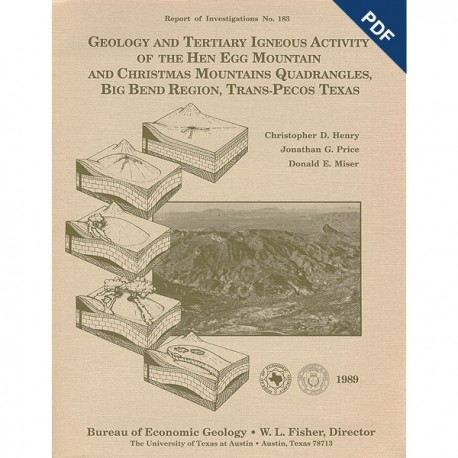
Geology and Tertiary Igneous Activity of the Hen Egg Mountain and Christmas Mountains Quadrangles... Digital Download
RI0183D
For a print version: RI0183.
RI0183D. Geology and Tertiary Igneous Activity of the Hen Egg Mountain and Christmas Mountains Quadrangles, Big Bend Region, Trans-Pecos Texas, by C. D. Henry, J. G. Price, and D. E. Miser. 105 p., 35 figs., 6 tables, 1 appendix, 1989. doi.org/10.23867/RI0183D.
To purchase this publication in book format, please order RI0183.
ABSTRACT
Cretaceous sedimentary rocks and Tertiary intrusive, extrusive, and volcaniclastic rocks dominate the geology of the Hen Egg Mountain and Christmas Mountains quadrangles in the Big Bend region of Texas. The Cretaceous rocks consist of limestones, shales, mudstones, and sandstones that are host rocks for the Tertiary intrusions.
This report focuses on the Tertiary intrusive and extrusive rocks. The intrusions were emplaced in several distinct intervals between 47 and 20 Ma ago (Eocene to Miocene) but are dominantly 44 to 40 Ma old. All intrusions are small (less than a few kilometers in diameter) and were shallowly emplaced as laccoliths, sills, and dikes. The Eocene intrusions fall into two petrographically and chemically distinct suites: (1) a silica-undersaturated series from nepheline-normative hawaiite to syenite and (2) a silica-oversaturated series from trachyandesite to high-silica, peralkaline rhyolite. The silica-undersaturated rocks dominantly form sills or dikes and, more rarely, laccoliths having little structural relief. The silicic rocks form laccoliths having considerable structural relief, including trap-door laccoliths, and, less commonly, sills or dikes. The undersaturated rocks occur primarily in the central part of the Hen Egg Mountain quadrangle; the oversaturated intrusions occur throughout both quadrangles.
A single nepheline-normative hawaiite sill was emplaced 28 Ma ago (late Oligocene) in the southeastern corner of the Christmas Mountains quadrangle. Abundant north-northwest-trending dikes of strongly nepheline-normative hawaiites and basalts were emplaced at 24 to 20 Ma (early Miocene), contemporaneous with initial Basin and Range faulting. These latter rocks commonly host mantle xenoliths.
Silicic volcanism accompanying late Eocene intrusion occurred in two areas. A caldera complex in the Christmas Mountains represents an unusual eruptive laccolith, a caldera type not previously recognized. These calderas developed on the Christmas Mountains dome, a large (8 x 5 km), elliptical laccolithic uplift that resulted from emplacement of the caldera magma body. The complex produced an extensive series of rhyolitic to quartz trachytic airfall and ash-flow tuffs, silicic lavas and domes, and coarse debris-avalanche deposits; these rocks are divided into five stratigraphic sequences. At least four caldera collapses accompanied eruption, and the fill in the two youngest calderas dips steeply inward, indicating post-eruption subsidence. More minor volcanism consisted of massive air-fall or ash-flow tuff associated with high-silica, peralkaline rhyolite domes in the northwest corner of the Hen Egg Mountain quadrangle.
The major structural features of the quadrangles are domes produced by intrusive emplacement. Laramide folding either did not occur or was a minor influence. Three north-northwest-trending Basin and Range fault zones transect the quadrangles. Displacement is mostly down to the west and less than 1 km.
The only significant mineral production in the area was of fluorite formed at the contacts between alkalic, silicic intrusions and Cretaceous carbonate host rocks. The presence of numerous prospects, the unusual trace-element enrichment in several of the fluorite deposits, and the overall geologic setting and types of igneous rocks suggest significant potential for deposits of rare metals.
Keywords: alkalic rocks, ash-flow tuffs, calderas, K-Ar, laccoliths, ore deposits, Tertiary, Trans-Pecos Texas
CONTENTS
Abstract
Introduction
Purpose
Previous Work
Regional Geologic Setting
Stratigraphy
Precambrian and Paleozoic Rocks
Cretaceous Rocks
Comanchean Series
Del Carmen Limestone
Sue Peaks Formation
Santa Elena Limestone
Del Rio Clay
Buda Limestone
Gulfian Series
Boquillas Formation
Pen Formation
Boquillas and Pen Formations undifferentiated
Aguja Formation
Javelina Formation
Tertiary Volcanic and Sedimentary Rocks
Chisos Formation
Alamo Creek Basalt Member
Undifferentiated, dominantly reworked tuffs
Devil's Graveyard Formation
Basal conglomerate
Basalt lava
Tuffaceous sediments
Undifferentiated Devil's Graveyard Formation
Tuff at Hen Egg Mountain
Quaternary Deposits
Alluvium
Terrace deposits
Alluvial-fan deposits
Colluvium and landslide blocks
Intrusive Rocks
Classification
Middle Eocene
Upper Middle Eocene.
Silica-undersaturated series
Hawaiitic sills and dikes
Christmas Mountains gabbro
Silica-oversaturated series
Rhyolites
High-silica peralkaline rhyolite
Low-silica peralkaline rhyolite
Flow-banded rhyolite
Quartz trachyte
Sparsely porphyritic, peralkaline quartz trachyte
Abundantly porphyritic, peralkaline quartz trachyte
Metaluminous quartz trachyte
Altered quartz trachyte
Trachyandesite
Dikes and small sills
Upper Oligocene
Lower Miocene
Igneous Petrology and Geochemistry
Silica Saturation and Chemical Classification of Igneous Rocks
Silica-undersaturated Rocks
Silica-oversaturated Rocks
Rocks of Contrasting Tectonic Settings.
Alkalic Rocks
Future Studies
The Christmas Mountains Caldera Complex
Stratigraphy of Caldera-Related Rocks
Sequence I: initial tuffs and lavas
Initial tuffs
Lower quartz trachyte lavas
Debris flows and tuffs
Ash-flow tuff at Little Christmas Mountain.
Upper quartz trachyte lavas
Undifferentiated sequence I
Related rocks in Big Bend National Park
Sequence II: debris-flow deposits, rheomorphic tuff, and lava dome
Lower debris-flow deposits
Rheomorphic tuff
Middle breccia
Quartz trachyte porphyry
Upper debris flows
Sequence III: massive debris-avalanche deposits
Sequence IV: caldera-fill tuff and breccia.
Western caldera
First tuff
Limestone collapse breccia
First breccia
Second tuff
Second breccia
Third breccia
Third tuff
Fourth breccia
Eastern caldera
First tuff
First breccia
Second tuff
Second breccia
Third tuff
Sequence V: quartz trachyte porphyry intrusions
Structure of the Christmas Mountains Dome and Calderas
The Christmas Mountains dome
First and second calderas
Main western caldera
Main eastern caldera
Late subsidence
Evolution of the Christmas Mountains Caldera Complex
Economic Geology
Fluorspar, Beryllium,and Molybdenum
Mercury
Coal
Other Mineral Commodities
Water Resources
Structure.
Laramide Structures
Structures Related to Igneous Activity
Metaluminous quartz trachyte laccolith
Paisano Peak.
Adobe Walls dome
Wildhorse Mountain intrusion
Paynes Waterhole anticline
"Pop-up" intrusions
Hen Egg Mountain intrusions
East-northeast-trending faults
Basin and Range Faults
Terlingua Creek graben.
Wildhorse - Hen Egg fault zone
Christmas Mountains fault zone
Implications of Dike Trends for Paleostress Orientations
Geologic History
Acknowledgments
References
Appendix: Chemical Analyses of Igneous Rocks, Christmas Mountains and Hen Egg Mountain Quadrangles
Figures
1. Location of the Hen Egg Mountain and Christmas Mountains quadrangles and other selected features of Trans-Pecos Texas and northern Mexico
2. Pre-mid-Tertiary tectonic elements of Trans-Pecos Texas and adjacent Mexico
3. Approximate distribution of Tertiary volcanic rocks of Trans-Pecos Texas and adjacent regions of Mexico, New Mexico, and Arizona
4. Published geologic maps that depict areas in and adjacent to the Hen Egg Mountain and Christmas Mountains quadrangles
5. Stratigraphy and thickness of Cretaceous rocks in the Christmas Mountains area
6. Photographs of Cretaceous rocks
7. Stratigraphy of volcanic and volcaniclastic rocks in and adjacent to the Hen Egg Mountain and Christmas Mountains quadrangles
8. Photographs of Tertiary rocks
9. Typical formation of Quaternary colluvium
10. Distribution of major mapped intrusive rock types
11. Photomicrographs of intrusive rocks
12. Flow-banded rhyolite in sill 1 km northwest of Adobe Walls dome, Hen Egg Mountain quadrangle
13. View to south of dikes of lower Miocene hawaiite in southwest corner of Hen Egg Mountain quadrangle
14. Igneous rocks in the Hen Egg Mountain and Christmas Mountains quadrangles in the chemical classification of alkalic rocks devised by Barker (1979)
15. Histogram of silica content of all samples listed in the appendix
16. Silicic igneous rocks of the Hen Egg Mountain and Christmas Mountains quadrangles
17. Plot of alkalinity, molar (Na + K)/A1, versus differentiation index
18. AFM diagram for nepheline-normative rocks 19. Plots of MgO and TiO, versus differentiation index
20. Alkali-silica and lime--s ilica plots of rocks from the Hen Egg Mountain and Christmas Mountains quadrangles
21. Index map of calderas in the Christmas Mountains caldera complex
22. Stratigraphy of initial tuffs and lavas west and south of the Christmas Mountains
23. General distribution of volcanic rocks of sequence I in the northwestern part of the Tule Mountain quadrangle.
24. Photographs of rocks of sequences I, II, and III
25. Stratigraphy of sequence II
26. Stratigraphy and thicknesses of caldera fill in the main western and eastern calderas
27. Photographs of caldera-fill rocks of sequence IV
28. Photographs of quartz trachyte intrusions of sequence V
29. Photographs illustrating structure of Christmas Mountains calderas
30. Relative enrichment of various trace elements in fluorspar associated with igneous rocks of Trans-Pecos Texas and adjacent New Mexico
31. Photographs of intrusive structures
32. Photographs of Basin and Range fault structures
33. Generalized distribution and orientation of dikes in the Christmas Mountains area
34. Histogram of K-Ar ages of igneous rocks of the Christmas Mountains area
35. Diagram showing evolution of the Christmas Mountains area
Tables
1. Magmatic-tectonic phases in Trans-Pecos Texas
2. K-Ar isotopic data,Christmas Mountains rocks
3. General characteristics of intrusive rock types
4. General stratigraphy of the Christmas Mountains caldera complex
5. Chemical analyses of Christmas Mountains area fluorspar
6. Chemical analyses of samples from mercury prospects on the south side of the Christmas Mountains
Plate (in inside back pocket of book)
Geologic map of the Hen Egg Mountain and Christmas Mountains quadrangles
Citation
Henry, C. D., Price, J. G., and Miser, D. E., 1989, Geology and Tertiary Igneous Activity of the Hen Egg Mountain and Christmas Mountains Quadrangles, Big Bend Region, Trans-Pecos Texas: The University of Texas at Austin, Bureau of Economic Geology, Report of Investigations No. 183, 105 p.

